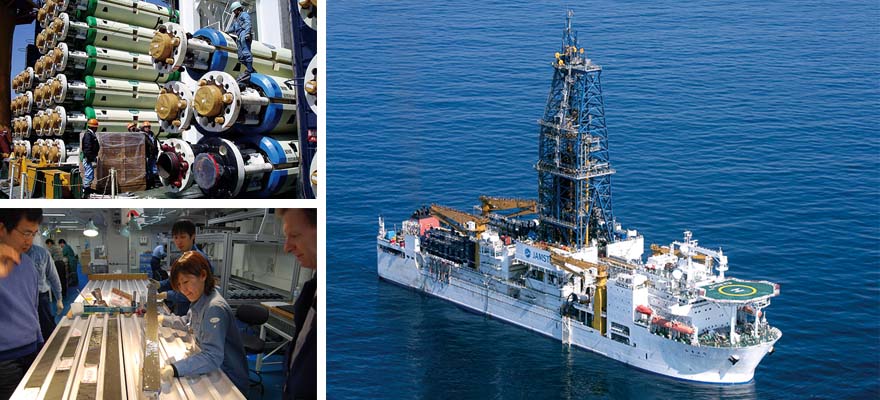Home > Highlighting JAPAN >Highlighting Japan November 2013>40th Year of ASEAN-Japan Friendship and Cooperation
Highlighting JAPAN
Science & Technology
DEEP SEA DRILLING WITH CHIKYU
Cutting-edge technology in earthquake reserch

The natural disaster that occurred in Japan on the March 11, 2011 resulted in an unparalleled level of damage. In a single minute, the trench-axis of Japan's continental shelf had slipped about 50 meters, setting off 30 meter high tsunami waves that combined with the series of other disasters would claim the lives of more than 15,000 people in northern Honshu.
Adding to the exceptional nature of 3/11 was the global scientific community's misplaced assurance that a disaster of this scale would never happen in Japan. Protecting people's precious lives and property is an important issue in Japan, where earthquakes occur frequently. If sufficient knowledge can be gained about the mechanisms behind earthquakes, it's expected that the damage resulting from earthquakes can be reduced. For this reason, within 13 months of the earthquake occurring, members of the Integrated Ocean Drilling Project, a consortium of 26 countries, were drilling 850 meters into the seabed at the site of the epicenter of the Tohoku disaster area, 7 km below sea level. Responsible for the deep-sea drill and extraction of core samples was JAMSTEC, the Japan Agency for Marine-Earth Science and Technology.
"Nobody had done rapid-response drilling in the ocean, nobody had drilled anything substantial under 7 km of water, nobody had placed an observatory in a fault that deep, and nobody had retrieved a string of instruments from that deep," said Professor Emily Brodsky, from UC Santa Cruz, who helped organize the drill.
The scientific drilling vessel used was the Chikyu, constructed in 2005 to the tune of 600 million US dollars. Chikyu possess the most powerful drilling capability in the world (7.000m under sea bed), up till now the digging of mantle and major seismogenic zone had not been attained but, now that has become possible to do. Chikyu has uncovered structures of the occurrence of some major earthquakes, the origin of its existence and is aiming to attain results in global scale environmental change and opening up new sea floor resource analysis. JAMSTEC is now preparing the Chikyu for the first ever deep-sea drill into the seismogenic zone, (the area in the Earth's crust responsible for most high-magnitude earthquakes). The designated site is the Nankai Trough, which has the shallowest access to the seismogenic zone at approximately 10 km below sea level. The trough, which is off the Kii Peninsula, is also expected to be host to a "monster earthquake" sometime in the near future.
"It's exciting, nervous but exciting," said Dr. Shinichi Kuramoto, Deputy Director of the JAMSTEC Center for Deep Earth Exploration. "Going that far down means we can measure the strength of the lock (of the two plates). We also plan to install a sensor into a bore-hole, so we can have real-time monitoring of the change in strain in the plates. This real-time data will help us to mitigate potential disasters as much as we can."
The Chikyu is able to perform this deep-sea drilling because of JAMSTEC's adoption of an industrial development called riser pipes. These are iron pipes with an internal diameter of 50 cm that are connected to each other with the assistance of a remotely operated robot (ROV), until it reaches the surface of the seabed. The drilling pipe is then put into the riser pipes and mud fluid is circulated from the vessel to the sea floor through the gap between the two pipes to maintain balance and prevent disintegration of the sea floor.
The seismogenic zone drill will add to a celebrated list of world-firsts for the Chikyu. In 2012, Japan Oil Gas and Metals National Corp (JOGMEC) used the vessel in the world's first ever successful extraction and production of methane from deposits found in ice below the seabed.
Methane has been one of the world's most common fossil fuels, and recent discoveries of large deposits of 'methane clathrate' in Japan and India's seawaters have led to the anticipation that the age of inexpensive gas will be extended.
Extracted from the seabed as frozen methane particles in clusters of ice, the fuel's separation has proven elusive until the trial extraction under the Chikyu's helm. Its huge success has led to Japan teaming up with India in another trial to remove and separate the methane in a manner viable to their commercial interests.
"People expect scientists to be able to predict earthquakes, but it's still very far from our current knowledge. We have to take one small step at a time. Drilling into the seismogenic zone will give us direct measurements. Then, anything is possible," said Dr. Kuramoto.
Japan is now at the forefront of earthquake research. While wave analysis using seismometers has formed the foundation of observation to date, Chikyu has been able to open up a new vista in the analysis of earthquakes from a material science point of view. Japan is once again taking the lead in this new and exciting field.
© 2009 Cabinet Office, Government of Japan






